By Nils Oliveto, M.S., CSCS
 ABSTRACT
ABSTRACT
This article suggests a way to incorporate a Subjective Exertion Feedback (SEF) scale into a periodization plan specific for field events athletes in track & field. This paper will also compare Borg’s RPE scale with this proposed SEF scale, discuss central nervous system (CNS) fatigue, highlight signs of subjective exertion specific to field anaerobic event athletes and demonstrate SEF data applications in various case scenarios for competitors performing in the jumping and the throwing events.
ABOUT THE AUTHOR
Nils Oliveto is an Olympic analyst for CBC Radio-Canada television, a peak performance consultant and a health/physical education instructor at Lionel-Groulx College in St-Thérèse (Québec, Canada). He has color-commentated the summer and winter Olympic and Paralympic Games, plus numerous World Championships and World Cup events, in both track & field and sliding winter sports (bobsled, luge, skeleton). He holds a Master of Science degree from the University of Oklahoma in Exercise Science with a research emphasis on periodization and training methodology. A former NCAA scholarship hammer thrower in Oklahoma, he has also represented Canada in various international athletic meets. He earned his Certified Strength and Conditioning Specialist (CSCS) through the National Strength and Conditioning Association (NSCA) and has previously published in the Strength & Conditioning Journal and Track Coach. He will broadcast this year’s 2024 Olympic and Paralympic Summer Games in Paris, France for CBC Radio-Canada Sports.
INTRODUCTION
Periodization can be defined as the manipulation of the body’s adaptive mechanism to facilitate an improvement in performance (4). High performance sports must follow a training methodology that is meticulously adapted to the physical properties required for optimal outcome (21). Although it is a widely accepted training strategy, traditional periodization is nonetheless an unpredictable discipline in which its results can be uncertain (25).
Some experts like Verkhoshansky (30) believe that periodization is not able to provide precise long-term preparation for an athlete. In addition, the traditional use of periodization can also display qualitative restrictions (32). An adequate yearly training plan should therefore be monitored by constant scrutiny of physiological and psychological indicators during training (26).
It is important to accurately quantify all power event training parameters into a periodization program (20). Training variables such as volume and intensity must constantly be manipulated all the way until the most important date of the competitive season.
The field events in athletics (jumps and throws) make no exception to the significance of selecting a suitable periodization (20). Using quantitative calculations as the only indicator of establishing volume loads and intensity can possibly overlook the fact that it does not take into consideration the jumper and thrower’s subjective perception of the training magnitude (27).
This article suggests the inclusion of a subjective component, named for the purpose of this paper the Oliveto Subjective Exertion Feedback (SEF) scale, into a periodization plan specific for field event athletes in track & field. This additional parameter can be used by the coaching staff to monitor and quantify an athlete’s own subjective fitness level and neuromuscular fatigue more meticulously in an attempt to ultimately reach the desired performance.
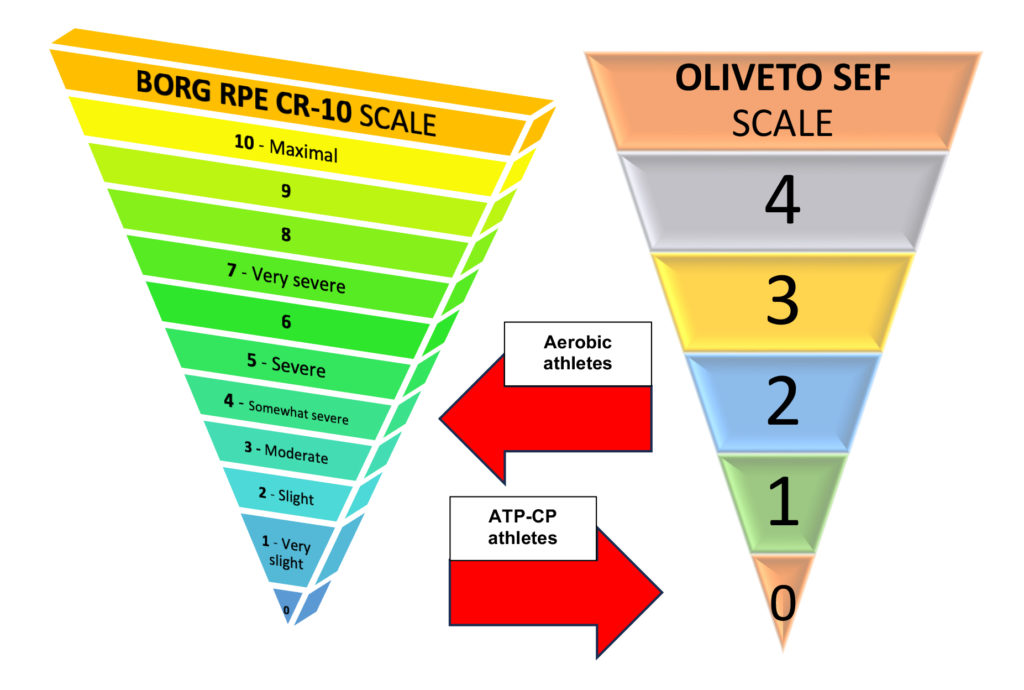
DIFFERENCE BETWEEN BORG’S RPE AND OLIVETO SEF
Perceived exertion during physical performance has been on the scientific radar for over half a century. It has been observed that symptoms of exertion and subjective estimate of the work intensity are unique to each athlete (17). Developed by Swedish scientist Gunnar Borg, the Borg Rating of Perceived Exertion (RPE) CR-10 scale is a tool for assessing an individual’s effort and exertion (5). The RPE CR-10 scale has been repeatedly used in the past in conjunction to monitoring aerobic intensity under laboratory exercise testing and prescription (2). It demonstrates a high correlation between heart rate and the level of perceived exertion (16).
Subjective feedback information coming from the athlete may be a valuable source of data in the planning of subsequent volume and intensity in a periodization scheme. Siff states that “traditional periodization can often be limited since all loading is based upon a fixed original input; hence the value of introducing a method of enhancing overall control and efficiency of performance” (27). Introducing a scale similar to Borg’s RPE CR-10 in the prescription of training could therefore overcome the restrictions of standard periodization.
Although the Borg scale is a valuable tool for aerobic / cardiovascular athletes relying on VO2 max-related performances, it cannot be appropriately applicable for field events athletes like jumpers and throwers in regard to their perceived effort since intensity for anaerobic events is not measured in the same matter. The Oliveto Subjective Exertion Feedback (SEF) scale is specifically adapted for ATP-CP power event exercises prescription and its scale ranges from 0 to 4 (see Figure 2).
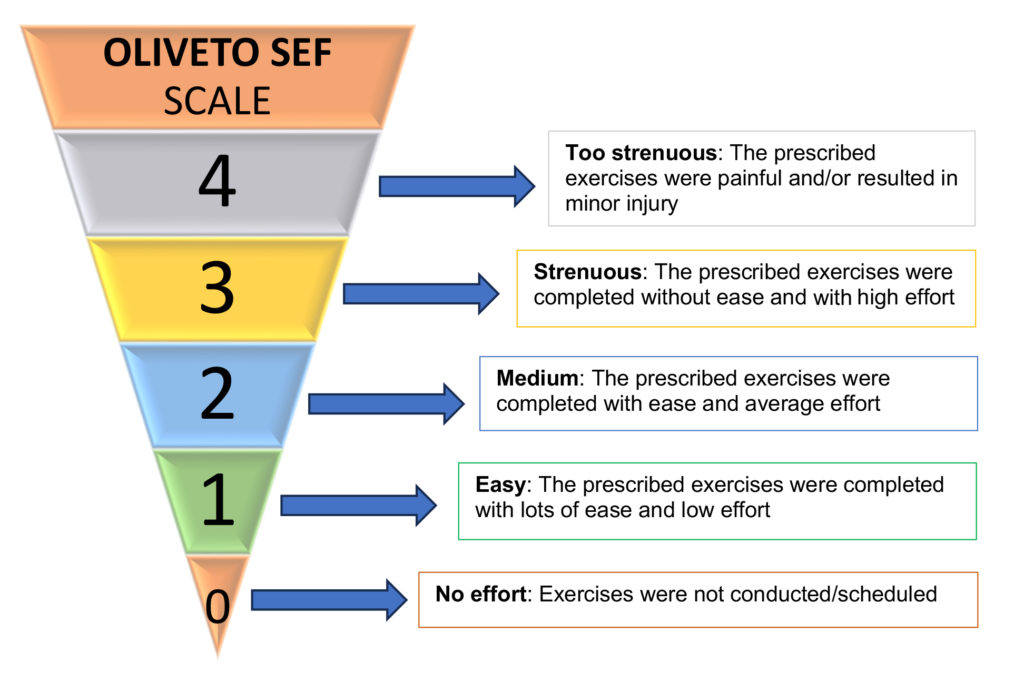
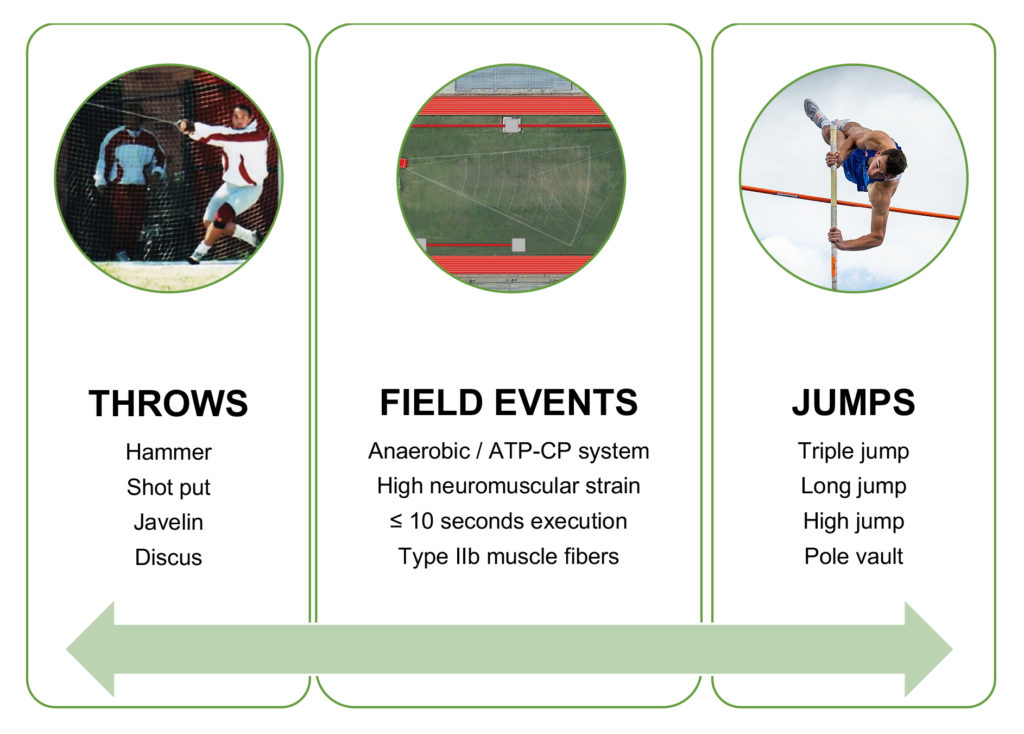
FIELD EVENTS ANAEROBIC PROFILE: JUMPS AND THROWS
Anaerobic parameters are the basics of all field event athletes in athletics. Jumpers and throwers utilize fast and explosive motions which reflect the usage of the ATP-CP system during the execution – less than ten seconds – of their respective event (see Figure 3). These athletes typically have a higher percentage of fast-twitch / type IIb muscle fibers. Their needs to execute high intensity actions, which augment motor unit recruitment and program specific neuromuscular patterns, are therefore crucial (12).
The success of a jumper/thrower athlete is achieved via a demanding series of speed drills, power/strength development, plyometrics, as well as countless of hours of technical jumping/throwing sessions (4). The event-specific volume (number of jumps/throws) and the event-specific intensity (measured distance jumped/thrown) data must also be well documented and incorporated into the periodization design (20).
To illustrate the importance of a power athlete’s subjective exertion feedback, we can look at the power/strength training component of a field event competitor. It is a common method for strength coaches to establish volume (number of sets and repetitions) and intensity (amount of weight) by using the percentage of a 1 RM maximum lift (18). However, this approach of determining subsequent training loads is not always accurate since it rarely reflects the exact fitness and/or mental state of the athlete on the day the 1 RM testing was recorded (26). This is the reason why athletes of the successful Bulgarian national weightlifting team, amongst others, establish their daily training intensity magnitude at a ‘’daily-perceived maximum load’’ (29).
A growing level of micromanagement must systematically be applied as the athlete is improving over the various periodization phases. Perceptive elements from the athlete can therefore be helpful in making cautious modifications during the establishment of training load parameters (25).
CENTRAL NERVOUS SYSTEM FATIGUE
Central Nervous System (CNS) fatigue is triggered by a decrease in individual motor neuron response, a diminution in motor neuron activity and a rise in inhibitory afferent feedback. Unlike peripheral fatigue, central fatigue affects the whole body. It is therefore harder and longer to recover nervously than muscularly (11).
It is obvious the neuromuscular strain resulting from all facets of the field event athlete’s anaerobic preparation cannot be overlooked when assessing a top performance periodization (23). This neuromuscular stress can lead to fatigue, which in return is deemed a subjective experience prompted by a variety of characteristics (30). A breakdown of the internal homeostasis causes fatigue and causes an upsurge in energy production required by an external stimulus. It leads to a decrease in performance related to an increase within the real/perceived exertion of an exercise (1).
CNS fatigue can also be linked with anxiety, personal difficulties and/or a decline in general stimulation (14). Impaired subjective perception of fatigue and general increase of CNS lethargy can be caused by outside factors connected to a stressful stimulus, including sleep deficiency (13).
Figure 4 illustrates a variety of undesirable SEF signs, specific to jumpers and throwers events, that field event competitors should subjectively monitor when giving feedback to their coaches following an exercise session.
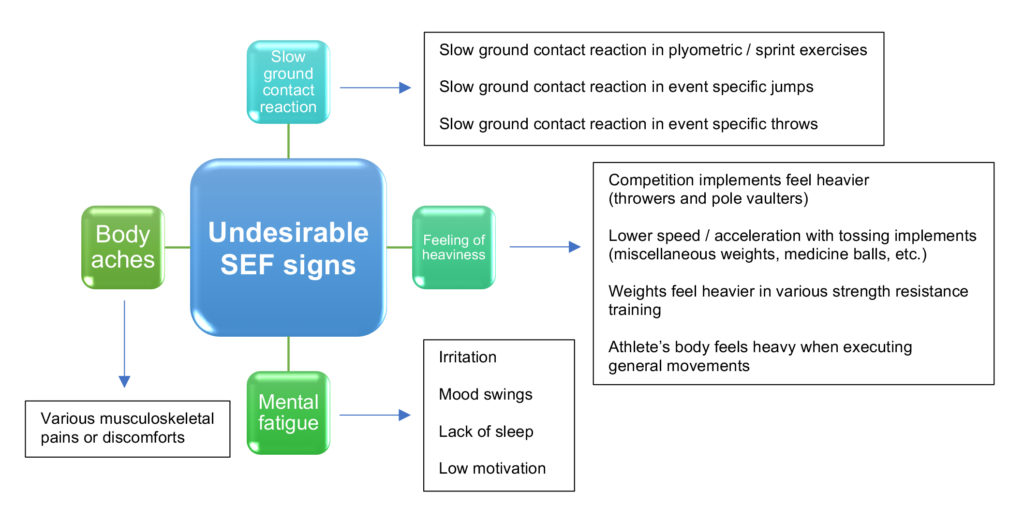
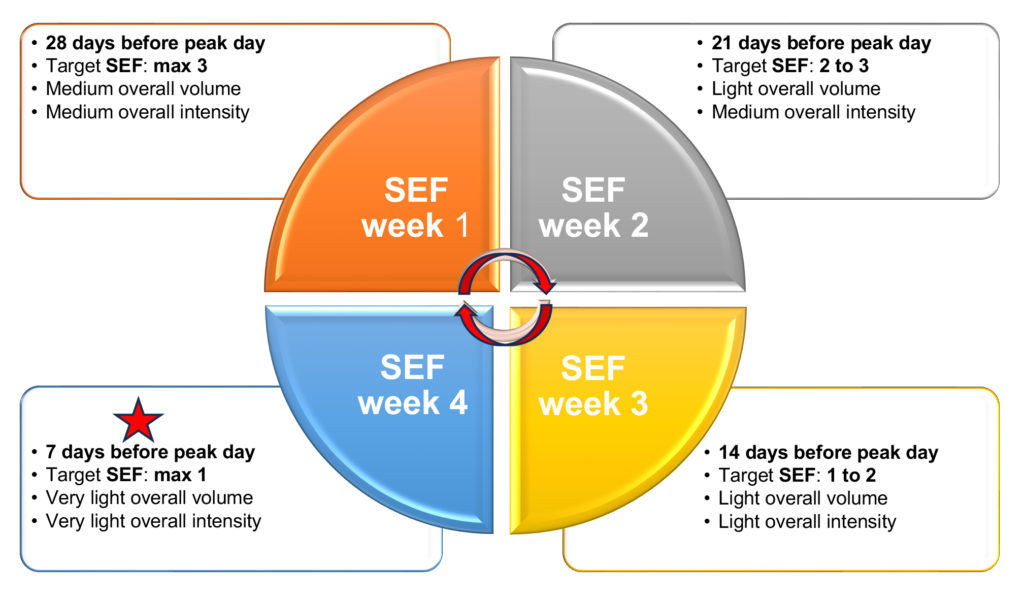
SEF SCALE PERIODIZATION APPLICATIONS
Periodization is the division of training phases within a training macrocycle. It comprises various mesocycles commonly known as the general phase, the preparatory phase, the competition phase and the transitional/active-rest phase.
As a hypothetical case scenario, we can demonstrate the application of the Oliveto SEF scale for field event athletes tapering for a peak performance mesocycle (competition phase) four weeks before the Olympic Games (see Figure 5). The SEF scale method can of course be used all year round in different periodization phases and cycles.
The following field event characteristics should be underlined when tapering for the season’s main competition, like the Olympics:
- Volume and intensity are gradually lowered in the last four weeks before the main event at the Olympic Games.
- Most field events athletes will cease competition and strictly focus on fine tuning two weeks before the Olympic Games.
- Volume and intensity are very light in the last seven days before the main event in order to maximize full recovery and supercompensation.
- The SEF’s target range values established by the coaching staff (which can obviously vary on a case-by-case basis) should correlate with the training volume and intensity described above.
The following four hypothetical cases will be used as examples for SEF applications:
• 4-week mesocycle (discus thrower)
28 days before peak day
(Table 1 / Graph 1)
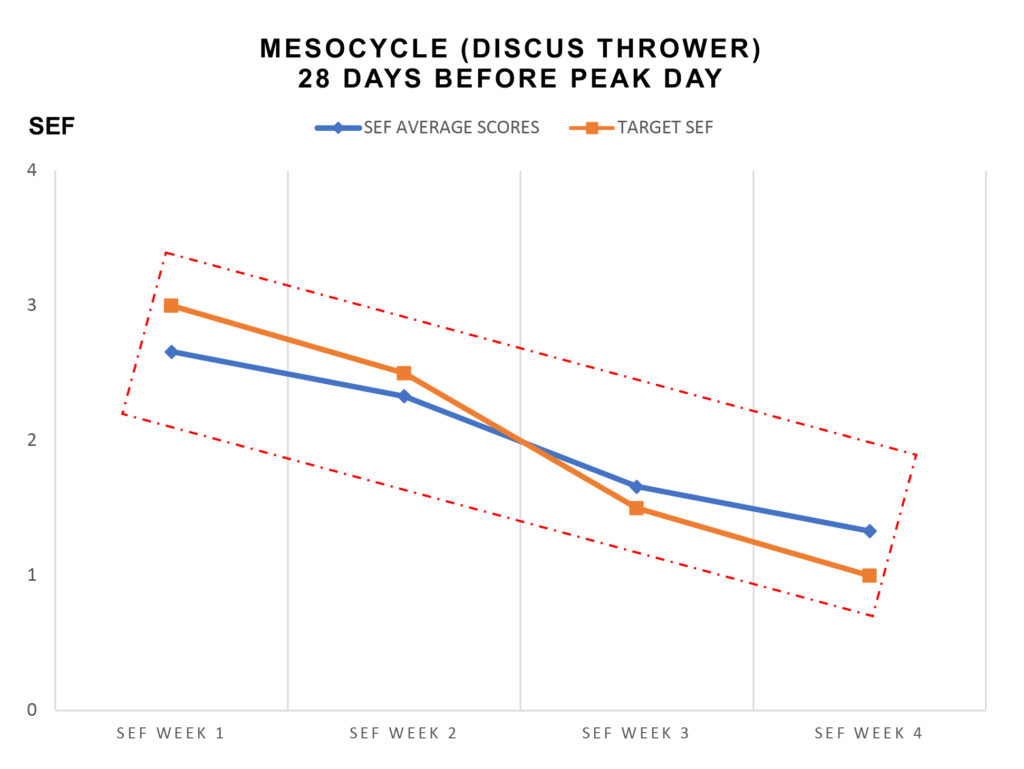

• 4-week mesocycle (triple jumper)
28 days before peak day
(Table 2 / Graph 2)
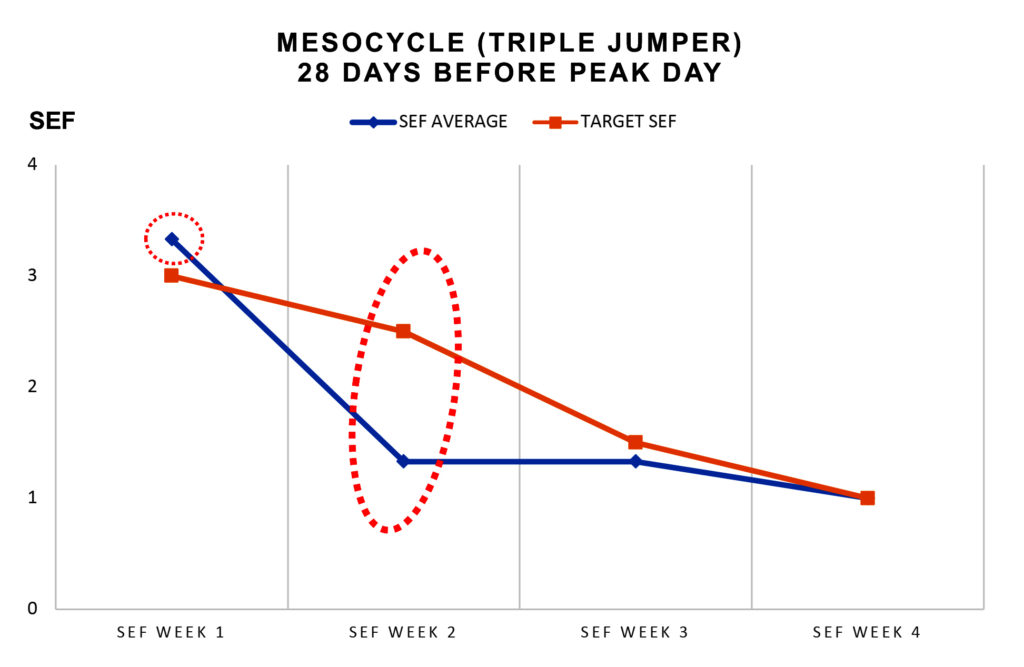

• 7-day microcycle (high jumper)
7 days before peak day
(Table 3)

• 7-day microcycle (javelin thrower)
7 days before peak day
(Table 4)

At the end of each training session, the athlete can share his/her SEF scale value with the coach, who now possesses a complementary “athlete’s subjective SEF data” that can be useful when re-establishing volume and intensity parameters for the subsequent workout sessions. It serves as valuable information and can influence the coaching staff’s choices of training loads for upcoming exercises.
To calculate the SEF average for each weekly microcycle (as computed in each of the four tables below), we can use the general formula: ![]()
and convert it into the following Oliveto SEF mathematical expression:
where:
∑ SEFps is the total plyometrics/speed training subjective exertion feedback,
∑ SEFwt is the total weight / resistance training subjective exertion feedback and
∑ SEFes is the total event specific training subjective exertion feedback.
It is important to insist that these tables below are only examples. All ‘’Target SEF scales’’ can be modified depending on the coach’s strategic approach in relation to specific training methodology and performance needs.
The discus thrower’s case demonstrates an ideal SEF leading up to the peak performance day. All SEF averages scales for all training components fall appropriately within the suggested target SEF scale corresponding to each weekly microcycle. Graph 1 clearly shows a high correlation between the SEF Average values and the Target SEF values.
The triple jumper’s case demonstrates glitches with its SEF results. This SEF for the ‘’plyometrics / speed work’’ in week 1 is too high (SEF = 4). We can argue the prescribed workout was too strenuous and the athlete could have, for instance, reported muscle or joint pain. As a result, the SEF average for week 1 was also too high (SEF average = 3.33). Consequently, an adjustment in training was necessary for week 2 in order for the athlete to recuperate and rest. Graph 2 clearly shows this discrepancy between the SEF average values and the Target SEF values, particularly on week 2, following the necessary adjustment resulting from the high SEF in week 1.
The high jumper’s case demonstrates an almost ideal SEF leading up to the peak performance day. All SEF averages scales for all training components fall appropriately within the suggested target SEF scale, except the SEF average for the specific high jump training component (SEF average = 1.14) which can be argued it is slightly too high. However, the overall Microcycle SEF average (0.90) doesn’t surpass the SEF target scale of 1, which works as intended in this case.
The javelin thrower’s case shows problems leading up to the peak performance day. The SEF average for the ‘’plyometrics / speed work’’ component is a bit high. The main concern comes from the javelin SEF (=4) seven days before the peak which indicates the event specific intensity workout was perceived by the athlete as too strenuous. This early specific javelin component microcycle difficulty led to a high SEF average (= 1.43). These two issues resulted in an overall microcycle SEF average of 1.14, which is slightly higher than the intended SEF average (max 1) for that microcycle.
OVERTRAINING
Overtraining can be defined as the decline in performance consequential of the incapacity to endure or adjust the intended training magnitude (19). It can be the result of psychological and physiological stress and, if not resolved, may eventually have a negative effect on performance (22). Stress is not only affected by the aimed magnitude of the training load, but is also influenced by the athlete’s perceived strain of that load during a workout session. A proficient coach should attempt to decrease the risk of overtraining by being aware of the athlete’s immediate response of that aforementioned workout (24). Extra after-effect levels of fatigue will overlay the existing ones if training takes place under an already pre-existing fatigue state (3).
One of the great advantages of using a SEF scale is to possibly reduce the risk of overtraining. If overtraining occurs, the training strategy needs to be re-evaluated in order to permit the athlete to return to the previous training state. The coach should also modify the exercises by reducing the volume / intensity of training and add recovery methods. An athlete can be fatigued to the point that a typical recovery period of a few days becomes insufficient. If a training load is excessive, overtraining recovery can take many weeks, and in some cases months to occur (28).
CONCLUSION
An athlete using a Subjective Exertion Feedback (SEF) scale to quantify the perceived field event intensity training magnitude efforts can result in:
- Reducing the risks of injuries
- Reducing the risks of overtraining
- Increasing the chances of continuous improvement
- Increasing the chances in realizing the targeted performance
An athlete’s training strategy should take into consideration fitness and fatigue after-effects in an attempt to make the most of the training load (6)(9)(10). Since fatigue is an expected outcome of training stress, fatigue management tactics are essential to a reliable periodization plan (7)(8)(31). One of the suggested tactics in diminishing the probability of fatigue can be the use of a training feedback scale like the SEF. Coaches can keep an even closer eye on all training empirical data for progress to occur and for injuries to be avoided (15). It is an accepted reality that periodization is not an exact strategic science and its predicted outcome can vary greatly. The exclusive use of quantitative parameters can very possibly lead to stagnation or to a decrease in the sought-after results. Taking into consideration the subjective exertion feedback of a field event athlete’s perceived rating of effort can potentially assist in enhancing overall control and efficiency of future performances.
REFERENCES
- Abd-Elfattah H.M., Abdelazeim F.H., Elshennawy S. Physical and Cognitive Consequences of Fatigue: A Review. J. Adv. Res. 2015; 6:351–358
- ACSM’s guidelines for exercise testing and prescription. American College of Sports Medicine. 5th edition. Williams and Wilkins. Pages 160-162. 1995
- Bannister, E.W. Modeling elite athletic performance. In: Physiological Testing of the High Performance Athlete. J.D. MacDougall, H.A. Wenger, and H.J. Green, eds. Champaign, IL: Human Kinetics, 1991. pp.403-424
- Bompa, T.O. Theory and Methodology of Training: The Key to Athletic Performance. Kendal/Hunt, Dubuque. Pages 375.1983
- Borg,GA. Psychophysical bases of perceived exertion. Med Sci Sports Exerc.1982; 14:377–381
- Chiu, L.Z.F.,and J.L. Barnes. The Fitness-Fatigue Model Revisited: Implications of Planning Short and Long-Term Training. NSCA J. volume 25, number 6, page 42-51. 2003
- Fry RW, Morton AR, Keast D. Periodisation and the prevention of overtraining. Can J Sport Sci. 1992 Sep;17(3):241-8
- Fry, R.W., A.R. Morton, and D. Keast. Periodization of training stress: A review. Can.J.Sports Sci. 17:234-240. 1992
- Hakkinen, K. and M. Kallinen. Distribution of strength training volume into one or two daily sessions and neuromuscular adaptations in female athletes. Electromyogr. Clin. Neurophysiol. 34: 35-42. 1991
- Hakkinen, K.A., A. Pakarinen, M.Alen, H. Kauhanen, and P.V. Komi. Neuromuscular and hormonal responses in elite athletes to two successive strength training sessions in one day. Eur. J. Appli. Physiology. 57(2): 133-139. 1988
- Howatson G, Brandon R and Hunter AM. The response to and recovery from maximum-strength and power training in elite track and field athletes. Int J Sports Physiol Perform 11: 356-362, 2016
- Johnson, M.J. Anaerobic Power Profiles for Track and Field [master’s thesis]. The University Wisconsin-Whitewater, Whitewater, Wisconsin. 2008
- Leonard C., Fanning N., Attwood J., Buckley M. The Effect of Fatigue, Sleep Deprivation and Onerous Working Hours on the Physical and Mental Wellbeing of Pre-Registration House Officers. Ir. J. Med. Sci. 1998. 167:22–25
- Lock A.M., Bonetti D.L., Campbell A.D.K. The Psychological and Physiological Health Effects of Fatigue. Occup. Med. (Lond.) 2018;68:502–511
- Mullineaux, M. Manipulating Training Variables for Safety and Effectiveness. NSCA J. 25(1):24. 2003
- Nerys Williams, The Borg Rating of Perceived Exertion (RPE) scale, Occupational Medicine, Volume 67, Issue 5, July 2017, Pages 404–405
- NSCA Book, 2003, pages 406-417
- O’Bryant, H. In: Roundtable Discussion: Periodization of Training-Part 1. NSCA Journal. 26(1).pages 50-69. 2004
- Oliveto N. Establishing Volume Load Parameters: A Different Look in Designing a Strength Training Periodization for Throwing Events. Strength and Conditioning Journal. 26: 52-55, 2004
- Oliveto N. Historical Foundations of Peak Performance Periodization and Its Applications to Elite Hammer Throwing [master’s thesis]. Norman, OK: University of Oklahoma, 2000
- Oliveto, N. Mental Imagery and Autogenic Training for your Athlete. Coaching Youth Sport Journal, pages 1-3. September 2003
- Oliveto N. Visual Sensory Deprivation (VSD): an Innovative Training Method for Proprioceptive Specific-Strength Enhancement. Track Coach. 236: 19-26, 2021
- Pendlay, G. In: Roundtable Discussion: Periodization of Training-Part 1. NSCA Journal. 26(1). 50-69. 2004
- Plisk, S.S. and M.H. Stone. Periodization Strategies. NSCA J. 25(6).pages 19-37. 2003
- Poliquin, C. Improving Relative Strength. Sports Science Periodicals on Research and Technology. 11(7). 1991
- Siff, M.C. Supertraining. Supertraining Institute, pages 311-390. Denver, USA 2000
- Stone, M.H. R.E. Keith, J.T. Kearney, S.J. Fleck, G.D. Wilson, and N.T. Triplet. Overtraining: A review of the signs, symptoms and possible causes. J. Appl. Sports. Sci. Res. 5(1): 35-50. 1991
- Takano, B. Bulgarian Training Program: The 1989 NSCA Bulgaria-USSR Study Tour- The Organization of the Bulgarian National Weightlifting Program. NSCA J. 11(5), pages 38-42. 1989
- Tornero-Aguilera JF, Jimenez-Morcillo J, Rubio-Zarapuz A, Clemente-Suárez VJ. Central and Peripheral Fatigue in Physical Exercise Explained: A Narrative Review. Int J Environ Res Public Health. 2022 Mar 25;19(7):3909
- Verkhoshansky YV. The Path to a Scientific Theory and Methodology of Sports Training. Teoriya I Praktika Fizischeskoi Kultury. 1997
- Viru, A., and M. Viru. Biochemical Monitoring of Sport Training. Champaign, IL: Human Kinetics, 2001
- Zheljazkov, T. About Some Permanent Factors in Present Sports Training. Teoriya I Praktika Fizischeskoi Kultury. 1998. 11-12